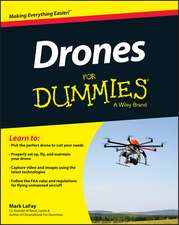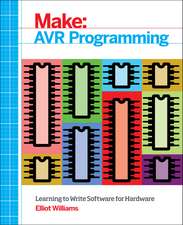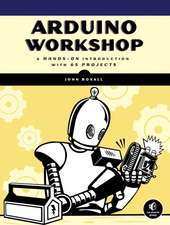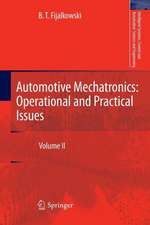Trends in Control and Decision-Making for Human–Robot Collaboration Systems
Editat de Yue Wang, Fumin Zhangen Limba Engleză Hardback – 9 feb 2017
The book focuses on quantitative methods and control design for guaranteed robot performance and balanced human experience from both physical human-robot interaction and social human-robot interaction. Its contributions develop and expand upon material presented at various international conferences. They are organized into three parts covering:
- one-human–one-robot collaboration;
- one-human–multiple-robot collaboration; and
- human–swarm collaboration.
Researchers and students working in controls, and the interaction of humans and robots will learn new methods for human–robot collaboration from this book and will find the cutting edge of the subject described in depth.
| Toate formatele și edițiile | Preț | Express |
|---|---|---|
| Paperback (1) | 794.69 lei 38-44 zile | |
| Springer International Publishing – 12 iul 2018 | 794.69 lei 38-44 zile | |
| Hardback (1) | 816.66 lei 38-44 zile | |
| Springer International Publishing – 9 feb 2017 | 816.66 lei 38-44 zile |
Preț: 816.66 lei
Preț vechi: 1074.55 lei
-24% Nou
Puncte Express: 1225
Preț estimativ în valută:
156.29€ • 162.56$ • 129.02£
156.29€ • 162.56$ • 129.02£
Carte tipărită la comandă
Livrare economică 11-17 aprilie
Preluare comenzi: 021 569.72.76
Specificații
ISBN-13: 9783319405322
ISBN-10: 3319405322
Pagini: 418
Ilustrații: XIX, 418 p. 173 illus., 121 illus. in color.
Dimensiuni: 155 x 235 x 27 mm
Greutate: 0.96 kg
Ediția:1st ed. 2017
Editura: Springer International Publishing
Colecția Springer
Locul publicării:Cham, Switzerland
ISBN-10: 3319405322
Pagini: 418
Ilustrații: XIX, 418 p. 173 illus., 121 illus. in color.
Dimensiuni: 155 x 235 x 27 mm
Greutate: 0.96 kg
Ediția:1st ed. 2017
Editura: Springer International Publishing
Colecția Springer
Locul publicării:Cham, Switzerland
Cuprins
Introduction.- Part I: One-Human–One-Robot Collaboration.- Human–Robot Cooperative Control of a Redundant Dual-Arm Mobile Manipulator.- Assistive Optimal Control-on-Request with an Application in Standing Balance Control and Reinforcement.- A Learning Algorithm to Select Consistent Reactions to Human Movements.- Continuous Switchings between Trajectory Tracking and Force Minimization in Human-Robot Collaboration.- Estimating Human Intention during a Human-Robot Cooperative Task Based on the Internal Force Model.- Part II: One-Human–Multiple-Robot Collaboration.- Shared-Control for the Kinematic Model of a group of Rear-Wheel Drive Cars.- An Intelligent Human–Robot Interaction System Using Reinforcement Learning and Neural Networks.- Regret-Based Decision-Making for Human–Robot Collaborative Assembly in Manufacturing.- Designing Robot Behavior for Safe Human–Robot Interactions.- To Ask or Not to Ask: A Foundation for the Optimization of Human–Robot Collaborations.- Part III: Human–SwarmCollaboration.- Mutual Trust-based Co-Design of Control and Scheduling for Human-Swarm Collaboration.- Human-Swarm Interactions via Coverage of Time-Varying Densities.- A Passivity-Based Approach to Human–Swarm Interactions and Passivity Analysis of Human Operators.
Notă biografică
Yue Wang received her B.S. degree in Mechanical Engineering from Shanghai University, China, in 2005 and M.S. and Ph.D. degrees in Mechanical Engineering from Worcester Polytechnic Institute in 2008 and 2011. She is an Assistant Professor in the Department of Mechanical Engineering at Clemson University. Prior to joining Clemson in 2012, she was a postdoctoral research associate in the Electrical Engineering Department at the University of Notre Dame. Her research interests include cooperative control and decision-making for human-robot collaboration systems, multi-agent systems, and control of cyber-physical systems. Dr. Wang received the National Science Foundation CAREER award and the Air Force Summer Faculty Fellowship in 2015, respectively. Her research has lead to 9 journal publications, 23 peer-reviewed conference papers, a book, and 2 book chapters. Dr. Wang is a member of IEEE, ASME, and AIAA. She is the co-chair for the IEEE Technical Committee on Manufacturing Automationand Robotic Control and organizers of several invited sessions in the American Control Conference.
Fumin Zhang is Associate Professor in the School of Electrical and Computer Engineering at the Georgia Institute of Technology. He received a PhD degree in 2004 from the University of Maryland (College Park) in Electrical Engineering, and held a postdoctoral position in Princeton University from 2004 to 2007. His research interests include mobile sensor networks, maritime robotics, control systems, and theoretical foundations for cyber-physical systems. He received the NSF CAREER Award in September 2009, the Lockheed Inspirational Young Faculty Award in March 2010, the ONR Young Investigator Program Award in April 2010, and the GT Roger P. Webb Outstanding Junior Faculty Award in April 2011. He is currently serving as the co-chair for the IEEE RAS Technical Committee on Marine Robotics, and the chair for the IEEE CSS Technical Committee on Robotic Control and Manufacturing Automation.
Fumin Zhang is Associate Professor in the School of Electrical and Computer Engineering at the Georgia Institute of Technology. He received a PhD degree in 2004 from the University of Maryland (College Park) in Electrical Engineering, and held a postdoctoral position in Princeton University from 2004 to 2007. His research interests include mobile sensor networks, maritime robotics, control systems, and theoretical foundations for cyber-physical systems. He received the NSF CAREER Award in September 2009, the Lockheed Inspirational Young Faculty Award in March 2010, the ONR Young Investigator Program Award in April 2010, and the GT Roger P. Webb Outstanding Junior Faculty Award in April 2011. He is currently serving as the co-chair for the IEEE RAS Technical Committee on Marine Robotics, and the chair for the IEEE CSS Technical Committee on Robotic Control and Manufacturing Automation.
Textul de pe ultima copertă
This book provides an overview of recent research developments in the automation and control of robotic systems that collaborate with humans. A measure of human collaboration being necessary for the optimal operation of any robotic system, the contributors exploit a broad selection of such systems to demonstrate the importance of the subject, particularly where the environment is prone to uncertainty or complexity. They show how such human strengths as high-level decision-making, flexibility, and dexterity can be combined with robotic precision, and ability to perform task repetitively or in a dangerous environment.
The book focuses on quantitative methods and control design for guaranteed robot performance and balanced human experience. Its contributions develop and expand upon material presented at various international conferences. They are organized into three parts covering:
Researchers and students working in controls, and the interaction of humans and robots will learn new methods for human–robot collaboration from this book and will find the cutting edge of the subject described in depth.
The book focuses on quantitative methods and control design for guaranteed robot performance and balanced human experience. Its contributions develop and expand upon material presented at various international conferences. They are organized into three parts covering:
- one-human–one-robot collaboration;
- one-human–multiple-robot collaboration; and
- human–swarm collaboration.
Researchers and students working in controls, and the interaction of humans and robots will learn new methods for human–robot collaboration from this book and will find the cutting edge of the subject described in depth.
Caracteristici
Broadens readers’ understanding of the interactions between humans and robot systems Shows the reader how principles of control theory can be applied to robotic systems of many types and applications Summarizes the latest studies of several leading research groups in the field Includes supplementary material: sn.pub/extras












